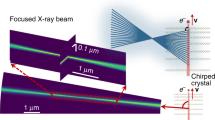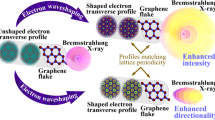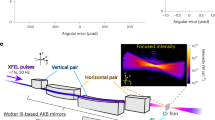Abstract
Tunable sources of X-ray radiation are widely used for imaging and spectroscopy in fundamental science, medicine and industry. The growing demand for highly tunable, high-brightness laboratory-scale X-ray sources motivates research into new fundamental mechanisms of X-ray generation. Here, we demonstrate the ability of van der Waals materials to serve as a platform for tunable X-ray generation when irradiated by moderately relativistic electrons available, for example, from a transmission electron microscope. The radiation spectrum can be precisely controlled by tuning the acceleration voltage of the incident electrons, as well as by our proposed approach: adjusting the lattice structure of the van der Waals material. We present experimental results for both methods, observing the energy tunability of X-ray radiation from the van der Waals materials WSe2, CrPS4, MnPS3, FePS3, CoPS3 and NiPS3. Our findings demonstrate the concept of material design at the atomic level, using van der Waals heterostructures and other atomic superlattices, for exploring novel phenomena of X-ray physics.
This is a preview of subscription content, access via your institution
Access options
Access Nature and 54 other Nature Portfolio journals
Get Nature+, our best-value online-access subscription
$29.99 / 30 days
cancel any time
Subscribe to this journal
Receive 12 print issues and online access
$209.00 per year
only $17.42 per issue
Buy this article
- Purchase on Springer Link
- Instant access to full article PDF
Prices may be subject to local taxes which are calculated during checkout



Similar content being viewed by others
Data availability
The data that support the plots within this paper and other findings of this study are available from the corresponding authors upon reasonable request.
Code availability
The codes that support the plots within this paper and other findings of this study are available from the corresponding authors upon reasonable request.
References
Novoselov, K. S. et al. Two-dimensional atomic crystals. Proc. Natl Acad. Sci. USA 102, 10451–10453 (2005).
Basov, D. N., Fogler, M. M. & García de Abajo, F. J. Polaritons in van der Waals materials. Science 354, aag1992 (2016).
Low, T. et al. Polaritons in layered two-dimensional materials. Nat. Mater. 16, 182–194 (2016).
Novoselov, K. S. et al. Electric field effect in atomically thin carbon films. Science 306, 666–669 (2004).
Castro Neto, A. H., Guinea, F., Peres, N. M. R., Novoselov, K. S. & Geim, A. K. The electronic properties of graphene. Rev. Mod. Phys. 81, 109–162 (2009).
Hao, J. et al. High performance optical absorber based on a plasmonic metamaterial. Appl. Phys. Lett. 96, 251104 (2010).
Lee, C., Wei, X., Kysar, J. W. & Hone, J. Measurement of the elastic properties and intrinsic strength of monolayer graphene. Science 321, 385–388 (2008).
Balandin, A. A. Thermal properties of graphene and nanostructured carbon materials. Nat. Mater. 10, 569–581 (2011).
Kane, C. L. & Mele, E. J. Quantum spin Hall effect in graphene. Phys. Rev. Lett. 95, 226801 (2005).
Wang, Q. H., Kalantar-Zadeh, K., Kis, A., Coleman, J. N. & Strano, M. S. Electronics and optoelectronics of two-dimensional transition metal dichalcogenides. Nat. Nanotechnol. 7, 699–712 (2012).
Chhowalla, M. et al. The chemistry of two-dimensional layered transition metal dichalcogenide nanosheets. Nat. Chem. 5, 263–275 (2013).
Evain, M., Brec, R. & Wbangbo, M. H. Structural and electronic properties of transition metal thiophosphates. J. Solid State Chem. 71, 244–262 (1987).
Latini, S., Olsen, T. & Thygesen, K. S. Excitons in van der Waals heterostructures: the important role of dielectric screening. Phys. Rev. B 92, 245123 (2015).
Jariwala, D., Sangwan, V. K., Lauhon, L. J., Marks, T. J. & Hersam, M. C. Emerging device applications for semiconducting two-dimensional transition metal dichalcogenides. ACS Nano 8, 1102–1120 (2014).
Susner, M. A., Chyasnavichyus, M., McGuire, M. A., Ganesh, P. & Maksymovych, P. Metal thio- and selenophosphates as multifunctional van der Waals layered materials. Adv. Mater. 29, 1602852 (2017).
Überall, H. High-energy interference effect of bremsstrahlung and pair production in crystals. Phys. Rev. 103, 1055–1067 (1956).
Korobochko, Y. S., Kosmach, V. F. & Mineev, V. I. On coherent electron bremsstrahlung. Sov. Phys. JETP 21, 834–839 (1965).
Baryshevsky, V. G. & Feranchuk, I. D. Parametric X-rays from ultrarelativistic electrons in a crystal: theory and possibilities of practical utilization. J. Phys. France 44, 913–922 (1983).
Baryshevsky, V. G., Feranchuk, I. D. & Ulyanenkov, A. P. Parametric X-ray Radiation In Crystals (Springer, 2005).
Jiang, P., Qian, X., Gu, X. & Yang, R. Probing anisotropic thermal conductivity of transition metal dichalcogenides MX2 (M = Mo, W and X = S, Se) using time‐domain thermoreflectance. Adv. Mater. 29, 1701068 (2017).
Zan, R. et al. Control of radiation damage in MoS2 by graphene encapsulation. ACS Nano 7, 10167–10174 (2013).
Lehnert, T., Lehtinen, O., Algara–Siller, G. & Kaiser, U. Electron radiation damage mechanisms in 2D MoSe2. Appl. Phys. Lett. 110, 033106 (2017).
Kirz, J., Jacobsen, C. & Howells, M. Soft X-ray microscopes and their biological applications. Q. Rev. Biophys. 28, 33–130 (1995).
de Groot, F. & Kotani, A. Core Level Spectroscopy of Solids (CRC Press, 2008).
Hitchcock, A. P. Soft X-ray spectromicroscopy and ptychography. J. Electron Spectrosc. Relat. Phenom. 200, 49–63 (2015).
Agarwal, B. K. X-ray Spectroscopy: an Introduction Vol. 15 (Springer, 2013).
Hayakawa, Y. et al. X-ray imaging using a tunable coherent X-ray source based on parametric X-ray radiation. J. Instrum. 8, C08001 (2013).
Carroll, F. E. Tunable monochromatic X rays: a new paradigm in medicine. Am. J. Roentgenol. 179, 583–590 (2002).
Okada, H. et al. Basic study of parametric X-ray radiation for clinical diagnosis using 125 MeV linear particle accelerator. J. Hard Tissue Biol. 24, 299–302 (2015).
Saldin, E. L., Schneidmiller, E. A. & Yurkov, M. The Physics of Free-Electron Lasers (Springer, 2000).
Ackermann, W. et al. Operation of a free-electron laser from the extreme ultraviolet to the water window. Nat. Photon. 1, 336–342 (2007).
Winick, H. & Doniach, S. Synchrotron Radiation Research (Springer, 2012).
Powers, N. D. et al. Quasi-monoenergetic and tunable X-rays from a laser-driven Compton light source. Nat. Photon. 8, 28–31 (2014).
Wong, L. J., Kaminer, I., Ilic, O., Joannopoulos, J. D. & Soljačió, M. Towards graphene plasmon-based free-electron infrared to X-ray sources. Nat. Photon. 10, 46–52 (2016).
Rosolen, G. et al. Metasurface-based multi-harmonic free-electron light source. Light Sci. Appl. 7, 64 (2018).
Pizzi, A. et al. Graphene metamaterials for intense, tunable, and compact extreme ultraviolet and X-ray sources. Adv. Sci. 7, 1901609 (2019).
Rivera, N., Wong, L. J., Joannopoulos, J. D., Soljačić, M. & Kaminer, I. Light emission based on nanophotonic vacuum forces. Nat. Phys. 15, 1284–1289 (2019).
Blazhevich, S. V. et al. First observation of interference between parametric X-ray and coherent bremsstrahlung. Phys. Lett. A 195, 210–212 (1994).
Feranchuk, I. D., Ulyanenkov, A., Harada, J. & Spence, J. C. H. Parametric X-ray radiation and coherent bremsstrahlung from nonrelativistic electrons in crystals. Phys. Rev. E 62, 4225–4234 (2000).
Fraser, J. S., Sheffield, R. L. & Gray, E. R. A new high-brightness electron injector for free electron lasers driven by RF linacs. Nucl. Instrum. Methods Phys. Res. A 250, 71–76 (1986).
Dunham, B. et al. Record high-average current from a high-brightness photoinjector. Appl. Phys. Lett. 102, 034105 (2013).
Li, X. et al. Dispersion engineering in metamaterials and metasurfaces. J. Phys. D 51, 054002 (2018).
Kaminer, I. et al. Spectrally and spatially resolved Smith–Purcell radiation in plasmonic crystals with short-range disorder. Phys. Rev. X 7, 011003 (2017).
Remez, R. et al. Spectral and spatial shaping of Smith–Purcell radiation. Phys. Rev. A 96, 061801 (2017).
Geim, A. K. & Grigorieva, I. V. Van der Waals heterostructures. Nature 499, 419–425 (2013).
Gjerding, M. N., Petersen, R., Pedersen, T. G., Mortensen, N. A. & Thygesen, K. S. Layered van der Waals crystals with hyperbolic light dispersion. Nat. Commun. 8, 320 (2017).
Herman, M. A. & Sitter, H. Molecular Beam Epitaxy: Fundamentals and Current Status (Springer, 2012).
Dapkus, P. D. Metalorganic chemical vapor deposition. Annu. Rev. Mater. Sci. 12, 243–269 (1982).
Graves, W., Kärtner, F., Moncton, D. & Piot, P. Intense superradiant X rays from a compact source using a nanocathode array and emittance exchange. Phys. Rev. Lett. 108, 263904 (2012).
Nanni, E. A., Graves, W. S. & Moncton, D. E. Nanomodulated electron beams via electron diffraction and emittance exchange for coherent X-ray generation. Phys. Rev. Accel. Beams 21, 014401 (2018).
Naumova, N. et al. Attosecond electron bunches. Phys. Rev. Lett. 93, 195003 (2004).
Lim, J., Chong, Y. & Wong, L. J. Terahertz-optical intensity grating for creating high-charge, attosecond electron bunches. New J. Phys. 21, 033020 (2019).
Attwood, D. T. Soft X-Rays and Extreme Ultraviolet Radiation (Cambridge Univ. Press, 2000).
Roessl, E. et al. Sensitivity of photon-counting based K-edge imaging in X-ray computed tomography. IEEE Trans. Med. Imaging 30, 1678–1690 (2011).
Wong, L. J. et al. Laser-induced linear-field particle acceleration in free space. Sci. Rep. 7, 11159 (2017).
Wang, W. L. & Kaxiras, E. Efficient calculation of the effective single-particle potential and its application in electron microscopy. Phys. Rev. B 87, 085103 (2013).
Susi, T. et al. Efficient first principles simulation of electron scattering factors for transmission electron microscopy. Ultramicroscopy 197, 16–22 (2019).
Enkovaara, J. et al. Electronic structure calculations with GPAW: a real-space implementation of the projector augmented-wave method. J. Phys. Condens. Matter 22, 253202 (2010).
Henke, B. L., Gullikson, E. M. & Davis, J. C. X-ray interactions: photoabsorption, scattering, transmission, and reflection at E = 50–30,000 eV, Z = 1–92. At. Data Nucl. Data Tables 54, 181–342 (1993).
Budniak, A. K. et al. Exfoliated CrPS4 with promising photoconductivity. Small 16, 1905924 (2020).
Acknowledgements
We thank Y. Kauffmann for advice and discussions. This work was supported by the ERC (Starter Grant no. 851780), the ISF (Grant no. 830/19) and the European Commission via the Marie Skłodowska-Curie Action Phonsi (H2020-MSCA-ITN-642656). H.H.S. also acknowledges the support of Marie Skłodowska-Curie Actions (H2020-MSCA-IF-2018-843830). K.S.T. acknowledges funding from the European Research Council (ERC) under the European Union’s Horizon 2020 research and innovation programme (grant no. \773122, LIMA). The Center for Nanostructured Graphene is sponsored by the Danish National Research Foundation, Project DNRF103. F.H.L.K. acknowledges financial support from the Government of Catalonia through the SGR grant, and from the Spanish Ministry of Economy and Competitiveness, through the “Severo Ochoa” Programme for Centres of Excellence in R&D (SEV-2015-0522), and Explora Ciencia FIS2017-91599-EXP. F.H.L.K. also acknowledges support by Fundacio Cellex Barcelona, Generalitat de Catalunya through the CERCA program, and the Mineco grants Plan Nacional (FIS2016-81044-P) and the Agency for Management of University and Research Grants (AGAUR) 2017 SGR 1656. Furthermore, the research leading to these results has received funding from the European Union’s Horizon 2020 under grant agreement no. 785219 (Core2) and no. 881603 (Core3) Graphene Flagship, and no. 820378 (Quantum Flagship). This work was supported by the ERC TOPONANOP under grant agreement no. 726001. L.J.W. acknowledges the support of the Agency for Science, Technology and Research (A*STAR) Advanced Manufacturing and Engineering Young Individual Research Grant (A1984c0043), and the Nanyang Assistant Professorship Start-up Grant. F.J.G.A. acknowledges support from the Spanish MINECO (Grant nos. MAT2017-88492-R and SEV2015-0522), ERC (Advanced Grant no. 789104-eNANO), the Catalan CERCA Program and Fundació Privada Cellex. I.K. was also supported by an Azrieli Faculty Fellowship.
Author information
Authors and Affiliations
Contributions
M.S. spearheaded the project, designed and performed the electron microscopy experiments, prepared the samples, analysed the data and developed the superlattice theory. A.K.B. contributed to the measurements and performed electron microscopy experiments. A.K.B., H.H.S., M.B., Y.A., S.T., F.H.L.K. and E.L synthesized the vdW materials and prepared the TEM samples. R.D. and M.K. advised on experimental aspects. X.S., Y.K. and F.J.G.A. developed and executed the PXR simulations. M.K.S. and K.S.T. performed the DFT simulations. L.J.W. developed and executed the CBS simulations. F.J.G.A., L.J.W., X.S. and I.K. contributed to the discussion of the experimental results, to the comparative analysis of the different theoretical mechanisms and to the overall conclusions. M.S. and I.K. conceived the idea. I.K. supervised the project.
Corresponding authors
Ethics declarations
Competing interests
The authors declare no competing interests.
Additional information
Publisher’s note Springer Nature remains neutral with regard to jurisdictional claims in published maps and institutional affiliations.
Supplementary information
Rights and permissions
About this article
Cite this article
Shentcis, M., Budniak, A.K., Shi, X. et al. Tunable free-electron X-ray radiation from van der Waals materials. Nat. Photonics 14, 686–692 (2020). https://doi.org/10.1038/s41566-020-0689-7
Received:
Accepted:
Published:
Issue Date:
DOI: https://doi.org/10.1038/s41566-020-0689-7
This article is cited by
-
Free-electron crystals for enhanced X-ray radiation
Light: Science & Applications (2024)
-
Intertwined electronic and magnetic structure of the van-der-Waals antiferromagnet Fe2P2S6
npj Quantum Materials (2023)
-
Shaping free-electron radiation via van der Waals heterostructures
Light: Science & Applications (2023)
-
Free-electron interactions with van der Waals heterostructures: a source of focused X-ray radiation
Light: Science & Applications (2023)
-
Quantum recoil in free-electron interactions with atomic lattices
Nature Photonics (2023)



